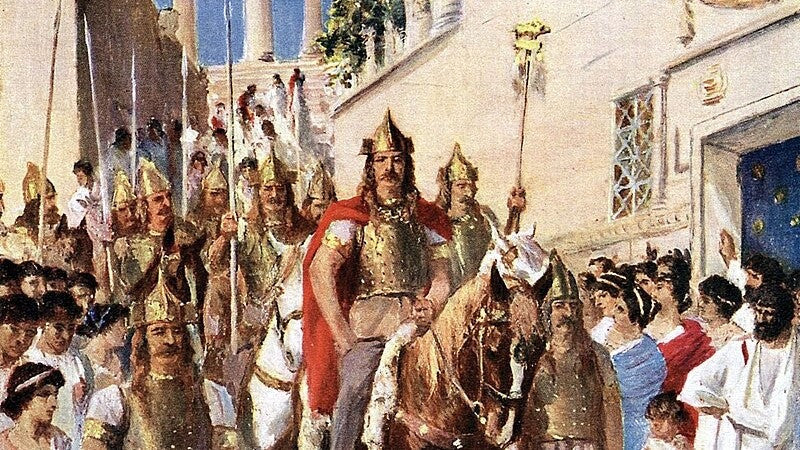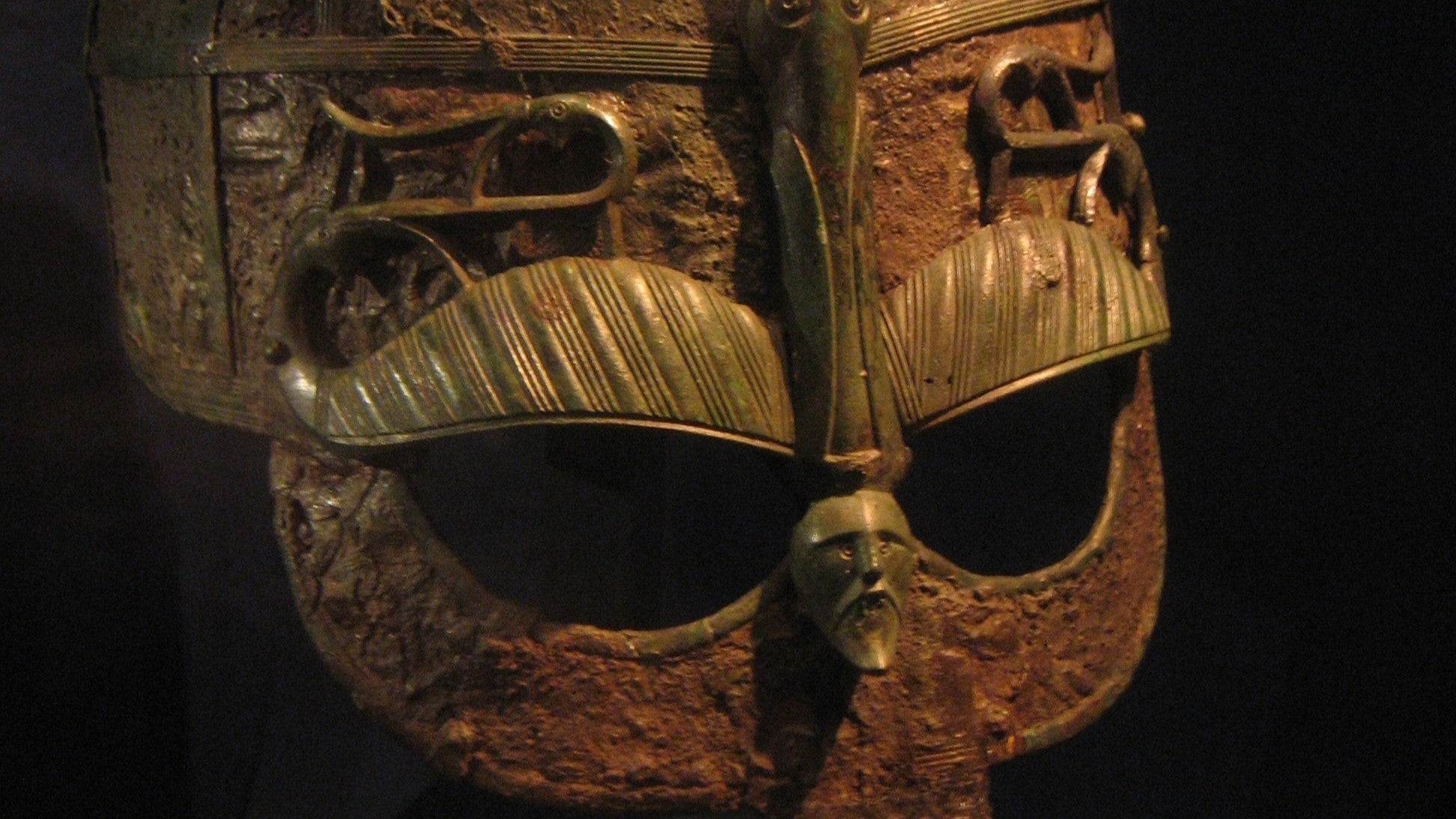
Why the Goths Sacked Rome: A History of Betrayal, War, and Respect
When the Visigoths sacked Rome in 410 CE under the leadership of Alaric I, the Western world was shaken. It was the first time in over 800 years that the Eternal City had fallen to a foreign enemy. However, the narrative of barbarian brutality often obscures a deeper and more complex historical truth. The Goths had not invaded Rome out of sheer bloodlust. Their conquest was the culmination of decades of Roman mistreatment, diplomatic failures, and broken promises. Paradoxically, even in victory, the Goths exhibited a profound respect for the city they had breached—protecting its churches, sparing civilians, and striving to preserve Roman traditions. This article explores why the Goths came to conquer Rome, what led to the conflict, and how they treated the city and its people in its aftermath.
The Goths Enter the Roman World

Ulfilas explains the gospel to the Goths, 1900
Pressures from the Huns
By the mid-fourth century CE, the Gothic tribes along the Danube—particularly the Tervingi and Greuthungi—faced mounting pressure from nomadic Hunnic incursions from the east. In 376 CE, facing annihilation, a large group of Tervingi under the leadership of Fritigern requested asylum from Emperor Valens to settle within the Roman Empire’s borders as foederati—federated allies who would serve in exchange for land and protection—essentially a Varangian Guard.
The Tervingi and the Danube Crossing of 376 CE
Valens, stationed in the Eastern Roman Empire, permitted the Tervingi to cross the Danube and settle in Roman territory in Moesia. However, the settlement was mismanaged from the outset. Roman officials such as Lupicinus and Maximus extorted the starving Goths, reportedly trading putrid meat and even dog flesh for the children of Gothic families. Rather than allies, the Goths were treated as subjugated peoples.
Roman Betrayal and the Seeds of Rebellion

The Goths cross the Alps (Painting: Fondo Antiguo CC BY 2.0)
The Famine and Roman Corruption
The humanitarian failure of the Danube settlement created deep resentment among the Gothic newcomers. A famine exacerbated their suffering, and appeals to Roman governors went unheeded. What began as a migration born of desperation quickly turned into a military revolt. The Romans had not only failed to uphold their agreements—they had humiliated and exploited a people they had promised to protect.
The Battle of Adrianople (378 CE)
Hostilities erupted, culminating in the catastrophic Roman defeat at the Battle of Adrianople on August 9, 378 CE. Emperor Valens, refusing to wait for reinforcements, led his forces against the Goths and was killed in the fighting. Two-thirds of the Roman army perished. This battle marked a turning point in Roman military history and underscored the empire’s failure to manage its borders diplomatically.
The Rise of Alaric and the Road to Rome

Alaric’s Early Service to Rome
Alaric, a noble of likely Tervingian background, initially served in the Roman military under the Eastern Emperor Theodosius I, fighting in campaigns against other barbarian groups. Despite his loyalty, Alaric’s talents went unrewarded after Theodosius’s death in 395 CE. Denied high command, Alaric rallied a force of disgruntled Gothic soldiers and declared himself king of the Visigoths.
Broken Promises and Political Intrigue
In the wake of Theodosius’s death, the Western Roman Empire—nominally ruled by the child-emperor Honorius—fell into the hands of ambitious generals like Stilicho and corrupt court officials in Ravenna. Gothic hopes for a lasting peace, including fair land grants and military titles, were continually dashed by Roman duplicity. Alaric’s repeated negotiations with Honorius’s regime ended in betrayal or indifference.
The Italian Campaigns
In retaliation, Alaric led his forces into Italy in 401 CE, raiding cities and forcing Roman authorities to negotiate. After several back-and-forth engagements—including a temporary peace and renewed conflict following Stilicho’s execution in 408—Alaric once more marched on Rome. The Roman Senate attempted to buy peace, but Honorius, safe in Ravenna, refused compromise.
The Sack of Rome (410 CE)

Goths traverse the river (Painting: Évariste Vital Luminais).
A Strategic Strike, Not a Massacre
On August 24, 410 CE, Alaric entered Rome through the Salarian Gate. Contrary to later depictions of unrestrained barbarism, the sack was tightly controlled. By this time, much of the Goths had already converted to Arian Christianity, and so the churches, including St. Peter’s Basilica and the Basilica of St. Paul Outside the Walls, were spared. Sacred objects were respected, and those who sought sanctuary within churches were protected.
What Was Spared, and Why
Contemporary accounts such as those by Orosius and Augustine—both sympathetic to Roman Christianity—emphasize the measured nature of the sack. Although valuables were looted and noble families were ransomed or taken hostage, widespread destruction and slaughter were notably absent. Pagan temples and the Senate’s archives were largely left intact.
After the Sack: Protection and Preservation

Alaric’s Treatment of the Roman People
Alaric’s conduct during and after the sack of Rome reflects a calculated effort not to destroy the city, but to use it as political leverage. Rather than inflicting indiscriminate violence, his forces maintained a remarkable degree of discipline. Roman civilians were not massacred, and mass enslavement was avoided. Churches and religious sanctuaries were explicitly spared, with many Romans taking refuge in Christian basilicas. Alaric’s objective was to pressure the imperial court in Ravenna into negotiations, not to raze the Eternal City. After just three days, the Goths withdrew from Rome, taking with them select hostages, supplies, and treasure—but leaving its buildings, population, and civic life largely untouched.
The Gothic Respect for Roman Institutions
The Goths who entered Rome in 410 CE were no strangers to the empire they confronted. Many had served within the Roman military, understood its customs, and admired its civilization. Alaric’s own entourage included Roman officials and Christian clergy, and the Gothic leadership had increasingly aligned with Arian Christianity, a belief system doctrinally distinct from Nicene orthodoxy but still rooted in shared Christian foundations. This religious affinity softened the cultural boundaries between Goth and Roman, even if political tensions remained unresolved.
The respect shown by Alaric and his successors was not an isolated gesture. Later Gothic rulers, most notably Theodoric the Great, reinforced this pattern of cultural diplomacy. A century after Alaric, Theodoric entered Rome as ruler of the Ostrogothic Kingdom and took deliberate steps to protect and promote Roman heritage. He retained the Senate, preserved Roman laws for his Roman subjects, and patronized public works, all while maintaining the Gothic identity and autonomy of his own people. Theodoric’s reign symbolized the complex relationship between the Germanic world and the Roman order—one not solely defined by conflict, but by centuries of cooperation, shared service, and mutual recognition.
This dual legacy—of conquest and continuity—underscores how the Gothic peoples, despite their role in ending imperial rule in the West, became pivotal custodians of Roman tradition in post-imperial Europe.
Long-Term Consequences and Gothic Legacy

The Last of the Goths Leaving Italy
The Visigothic Kingdom in Gaul and Hispania
After Alaric’s death later in 410 CE near Cosenza, his successor Ataulf led the Visigoths into Gaul and then into Hispania. There, they established the Visigothic Kingdom, which would endure until the early 8th century. This kingdom preserved many Roman customs, legal frameworks, and institutions. Roman aristocrats were incorporated into the ruling elite, and Latin remained the language of administration.
Cultural Continuity and Synthesis
Rather than destroy Roman civilization, the Goths helped perpetuate it in new forms. They adopted Roman urban planning, dress, and political titles. Their law codes, such as the Codex Euricianus, combined Roman legal tradition with Gothic customary law. The result was not a barbarian rupture but a complex fusion that shaped early medieval Europe.
The Visigothic conquest of Rome was not an act of unprovoked savagery, but a calculated response to decades of Roman betrayal, exploitation, and political failure. When the Goths finally sacked the city, they did so with surprising restraint and reverence. Far from annihilating Roman civilization, they helped preserve its legacy in new forms. The sack of 410 CE stands not only as a milestone in Rome’s decline but also as a testament to the resilience and adaptability of both Roman and Gothic cultures.
ᚸ
Frequently Asked Questions (FAQs)
Why did the Goths originally come into Roman territory?
The Tervingi Goths sought refuge from Hunnic invasions and crossed the Danube in 376 CE with Roman permission, expecting land and protection as allies.
What caused the Gothic revolt against Rome?
Roman officials extorted and starved the Gothic refugees, violating agreements. This mistreatment led to rebellion and the pivotal Battle of Adrianople in 378 CE.
Did the Goths destroy Rome during the sack of 410 CE?
No. The sack was controlled and relatively restrained. Churches were spared, civilians were protected, and key Roman institutions remained intact.
How did the Visigoths treat Roman culture afterward?
The Visigoths preserved and adapted many Roman customs, laws, and administrative practices, especially after founding their kingdom in Hispania.
Who led the Goths during the sack of Rome?
Alaric I, a former Roman military officer and the first king of the Visigoths, led the sack of Rome in 410 CE after failed negotiations with Emperor Honorius.
References
Ammianus Marcellinus, Res Gestae
Jordanes, Getica
Zosimus, Historia Nova
Orosius, Historiarum Adversum Paganos
Augustine, De Civitate Dei
Heather, Peter. The Fall of the Roman Empire: A New History of Rome and the Barbarians. Oxford University Press, 2006.
Kulikowski, Michael. Rome's Gothic Wars. Cambridge University Press, 2006.
Wolfram, Herwig. History of the Goths. University of California Press, 1990.
Halsall, Guy. Barbarian Migrations and the Roman West. Cambridge University Press, 2007.








